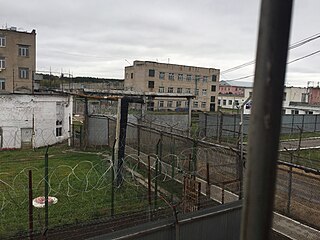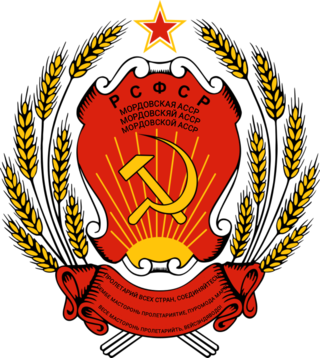Related Research Articles

The last Soviet Union (USSR)-era flag was adopted by the Russian SFSR in 1954 and used until 1991. The flag of the Russian SFSR was a defacement of the flag of the Soviet Union. The constitution stipulated:
The state flag of the Russian Soviet Federative Socialist Republic (SFSR) presents itself as a red, rectangular sheet with a light-blue stripe at the pole extending all the width [read height] which constitutes one eighth length of the flag.
The 1977 Constitution of the Soviet Union, officially the Constitution of the Union of Soviet Socialist Republics, was the constitution of the Soviet Union adopted on 7 October 1977.

Karachay-Cherkessia, officially the Karachay-Cherkess Republic, is a republic of Russia located in the North Caucasus. It is administratively part of the North Caucasian Federal District. Karachay-Cherkessia has a population of 469,865. Cherkessk is the largest city and the capital of the republic.

Nizhny Novgorod Oblast is a federal subject of Russia. Its administrative center is the city of Nizhny Novgorod. It has a population of 3,310,597 as of the 2010 Census. From 1932 to 1990 it was known as Gorky Oblast.

The Karakalpak Autonomous Soviet Socialist Republic, also known as Soviet Karakalpakstan or simply Karakalpakstan, was an autonomous republic within the Soviet Union. Until 20 July 1932, it was called the Karakalpak Autonomous Oblast. On 5 December 1936, it was moved from the Russian SFSR to the Uzbek SSR. It was the only ASSR in Soviet Central Asia.

The Checheno-Ingush Autonomous Soviet Socialist Republic, abbreviated as the Checheno-Ingush ASSR, was an autonomous republic within the Russian Soviet Federative Socialist Republic, in existence from 1936 to 1944 and again from 1957 to 1992. Its capital was Grozny. The 1979 census reported the territory had an area of 19,300 square kilometres (7,500 sq mi) and a population of 1,155,805 : 611,405 being Chechens, 134,744 Ingush, and the rest being Russians and other ethnic groups.

Of all the languages of Russia, Russian, the most widely spoken language, is the only official language at the national level. There are 26 languages which are considered official languages in various regions of Russia, along with Russian. There are over 100 minority languages spoken in Russia today. From 2020, amendments to the Russian Constitution stipulate that Russian is the language of the "state forming people". With president Vladimir Putin's signing of an executive order on 3 July 2020 to insert the amendments into the constitution, they took effect on 4 July 2020.

Vagrancy is the condition of homelessness without regular employment or income. Vagrants usually live in poverty and support themselves by begging, scavenging, petty theft, temporary work, or social security. Historically, vagrancy in Western societies was associated with petty crime, begging and lawlessness, and punishable by law with forced labor, military service, imprisonment, or confinement to dedicated labor houses.

A corrective colony is the most common type of prison in Russia and some other post-Soviet states. Such colonies combine penal detention with compulsory work. The system of labor colonies and camps originated in 1929, and after 1953 the corrective penal colonies in the Soviet Union developed as a post-Stalin replacement of the Gulag labor camp system.

The Declaration of State Sovereignty of the Russian SFSR was a political act of the Russian Soviet Federative Socialist Republic, then part of the Soviet Union, which marked the beginning of constitutional reform in Russia. The Declaration was adopted by the First Congress of People's Deputies of the Russian SFSR on 12 June 1990. It proclaimed the sovereignty of the Russian SFSR and the intention to establish a democratic constitutional state within a liberalized Soviet Union. The declaration also states the following:

The Russian Soviet Federative Socialist Republic, previously known as the Russian Soviet Republic and the Russian Socialist Federative Soviet Republic, as well as being unofficially referred to as Soviet Russia, the Russian Federation, or simply Russia, was an independent federal socialist state from 1917 to 1922, and afterwards the largest and most populous Soviet socialist republic of the Soviet Union (USSR) from 1922 to 1991, until becoming a sovereign part of the Soviet Union with priority of Russian laws over Union-level legislation in 1990 and 1991, the last two years of the existence of the USSR. The Russian SFSR was composed of sixteen smaller constituent units of autonomous republics, five autonomous oblasts, ten autonomous okrugs, six krais and forty oblasts. Russians formed the largest ethnic group. The capital of the Russian SFSR and the USSR as a whole was Moscow and the other major urban centers included Leningrad, Stalingrad, Novosibirsk, Sverdlovsk, Gorky and Kuybyshev. It was the first Marxist–Leninist state in the world.

The passport system of the Union of Soviet Socialist Republics was an organisational framework of the single national civil registration system based upon identification documents, and managed in accordance with the laws by ministries and other governmental bodies authorised by the Constitution of the USSR in the sphere of internal affairs.
An employment record book is an official personal document recording the employment status of its owner over time. Some European countries issue such documents, others did earlier. The first employment record books are said to have been issued in German Reich in 1892 in the mining industry.

Czech law, often referred to as the legal order of the Czech Republic, is the system of legal rules in force in the Czech Republic, and in the international community it is a member of. Czech legal system belongs to the Germanic branch of continental legal culture. Major areas of public and private law are divided into branches, among them civil, criminal, administrative, procedural and labour law, and systematically codified.

The Decree on Separation of Church from State and School from Church is a legal act adopted by the Council of People's Commissars of the Russian Soviet Federative Socialist Republic on 20 January 1918 came into force on 23 January that year, the day of official publication. It installed the secular nature of the state power, proclaimed the freedom of conscience and religion; religious organizations were deprived of any property rights and the rights of a legal entity. It laid the foundation for the deployment of atheistic propaganda and atheistic education.

The national emblem of the Mordovian Autonomous Soviet Socialist Republic was adopted in 1937 by the government of the Mordovian Autonomous Soviet Socialist Republic. The emblem is identical to the emblem of the Russian Soviet Federative Socialist Republic.

Honored Artist of the Russian Soviet Federated Socialist Republic was an honorary title of the RSFSR.
References
- 1 2 Кодекс законов о труде 1918 года // Приложение из учебного пособия И. Я. Киселева «Трудовое право России» (Москва, 2001). — Собрание Узаконений и Распоряжений Рабочего и Крестьянского Правительства РСФСР. 1918; № 87–88. Ст. 905
- ↑ "Canada Labour Code" (PDF). Department of Justice. Archived from the original (PDF) on January 6, 2011. Retrieved February 14, 2011.
- ↑ "Summary of Labour Codes 2020". Labour Codes 2020. March 29, 2021.
{{cite web}}: Missing or empty|url=(help) - ↑ Constitution of the R.S.F.S.R. (1918) // СУ РСФСР. 1918. № 51. ст. 582.
- ↑ Bělina, Miroslav. "Nový zákoník práce". Právní rozhledy, May 9, 2006.
- ↑ "Schválený návrh nového zákoníku na webu Ministerstva vnitra ČR" (PDF).